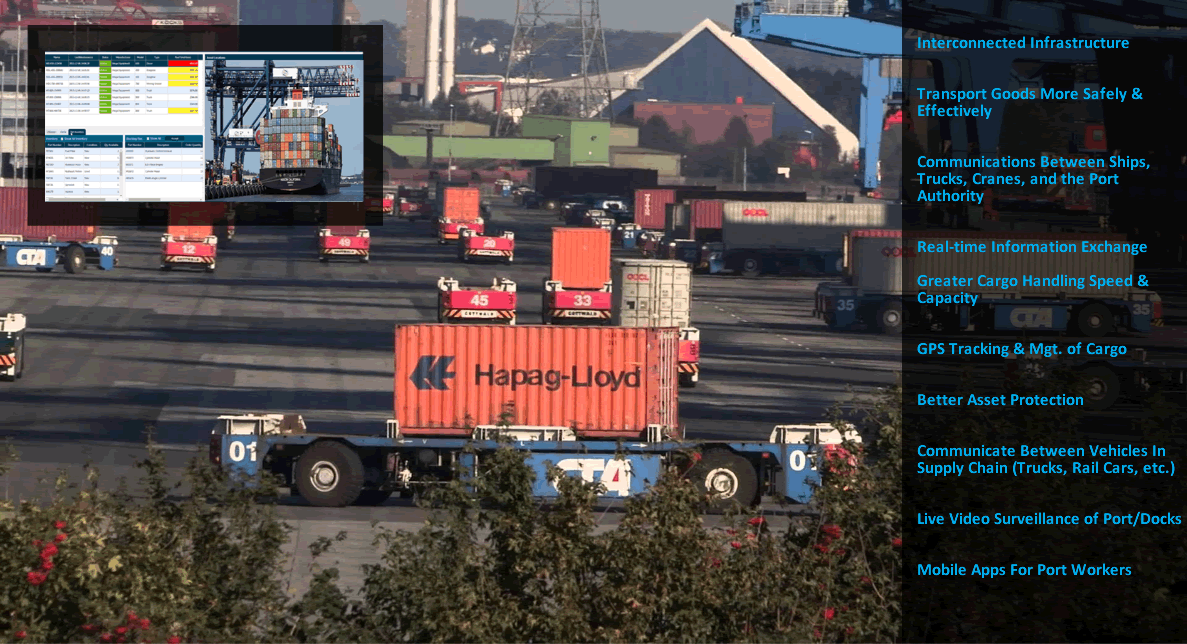Transportation & Logistics - Seaport Management
Transportation & Logistics
Seaport Management

Seaport Management Challenges:
Seaport Management Challenges:
Seaports are playing catch-up with the large Transportation & Logistics (T&L) players when it comes to developing insight driven solutions and IIoT applications. However, determining which technologies, how to implement them and the way in which they can support the overall digital strategy of the port remains the main challenge.
The diverse nature of a port, with a wide variety of companies and ecosystems, operating different kinds of equipment and requiring different types of products and services creates a complicated environment with multiple stakeholders. In addition to heterogeneity of data, a fear of transparency also remains a major issue. Ports are typically comprised of a cluster of competing companies. Thus, they are often very hesitant to share information with a central port authority that has the ability to aggregate and distribute the data amongst the stakeholders involved. In addition the interaction with the surrounding environment, both ecological and social, adds an extra layer of complexity to port development.
Operational Distinction:
From a supply side, namely port authorities, capacity, efficiency, reliability, support and costs are key drivers of value proposed to the clients (e.g. terminal operators). On the demand side comprised of both logistics supply (warehouses, transport providers, terminal operators) and demand (industrial sites, stowage companies, etc.) users might want extra services like savings in time, security, traceability, etc.Heterogeneous Technologies:
Creating a smart network of things that interact with each other requires the integration of many different technologies proprietary to different business processes, different actors in the logistical chain, and even different parts of the world. The large disparities in data types, as well as the different types of equipment, operating systems, and technological standards pose a great challenge for centralized data management and interchange.Fear of Transparency:
The IIoT is technology dependent on the free flow of data from smart devices to a central platform that coordinates the aggregation, analysis, and interchange of this data. However, many competing firms pass through ports, and they are often very hesitant to share information with a central authority that will aggregate this information with that of competitors.Business Process Reengineering (BPR):
IIoT requires not just the adoption of a new technology, but the rethinking and reengineering of entire business processes linked to it. This poses an obvious challenge, which requires much time and effort to get right, along with input and feedback from all stakeholders.IIoT applications provide more added value than only updating existing frameworks and streamlining established business models. In order to maximize potential of insight driven solutions, port authorities must rethink their orthodoxies about value creation and value capture.
Seaport Management Solutions:
Seaport Management Solutions:
Port Infrastructure:
- In order to protect a port's investment in infrastructure, Zotera™ embeds sensors and communicative capacities in the port's main tangible assets. This includes smart lighting, which illuminates only those areas necessary, based on motion detection, which saves energy costs. Lighting could also be adjusted automatically so that extra emphasis is placed on specific objects or locations that require attention.
- Sensors are capable of monitoring the use of assets (e.g. trucks, cranes, carriers, roads, etc.) and infrastructure (e.g. roads, parking lots, warehouse storage rooms, etc.) identify recurring underused capacity and allow for making adaptations to optimize utilization by relocating assets or rerouting goods flows.
- Zotera™ can provide smart storage systems with temperature, humidity, ventilation, and barometric pressure sensing ability in warehouses or containers to detect the needs of the cargo they contain and adjust these factors to increase product quality and decrease cargo damage.
- Cameras, contact closure sensors, and heat detection sensors along with alarm systems can prevent theft, and provide solid input for planning security improvements.
- Smart maintenance systems are able to track the usage and wear-and-tear on fixed assets, and can pre-emptively detect damages and malfunctions, saving tremendous costs on repairs, replacements, and mitigation in case of a breakdown. They also extend the life-cycles of port assets and infrastructure, and reduce the likelihood of defects that would disturb the normal flow of activity in the port.
- Certain key infrastructure can be equipped with smart meters that can monitor and control energy use by adjusting factors like temperature, pressure, electric drivers, etc.
Traffic Management:
Placing sensors on roads and bridges to track and manage the roadway traffic in the port provide continuous updates on the status of bridges (i.e. open/closed) and traffic throughout the port. This data allows a traffic management system to make efficient decisions on directing traffic flows to optimize routs, and therefore minimize congestion and transit time for all customers. Traffic lights can also be adapted accordingly.Trade Flow Management:
RFID can inform port authorities at all times what is moving around in the port, what the origin and destination are of goods, what the expected delivery times are, and what port services need to be deployed for proper handling (i.e. how to load and unload cargo).With GPS and geo-referencing, pick-up services or warehouses can automatically be alerted of delays to readjust delivery or inbound schedules, and adapt handling requirements (e.g. for sensitive or perishable goods); and status sensors on cranes, pallet loaders, etc.